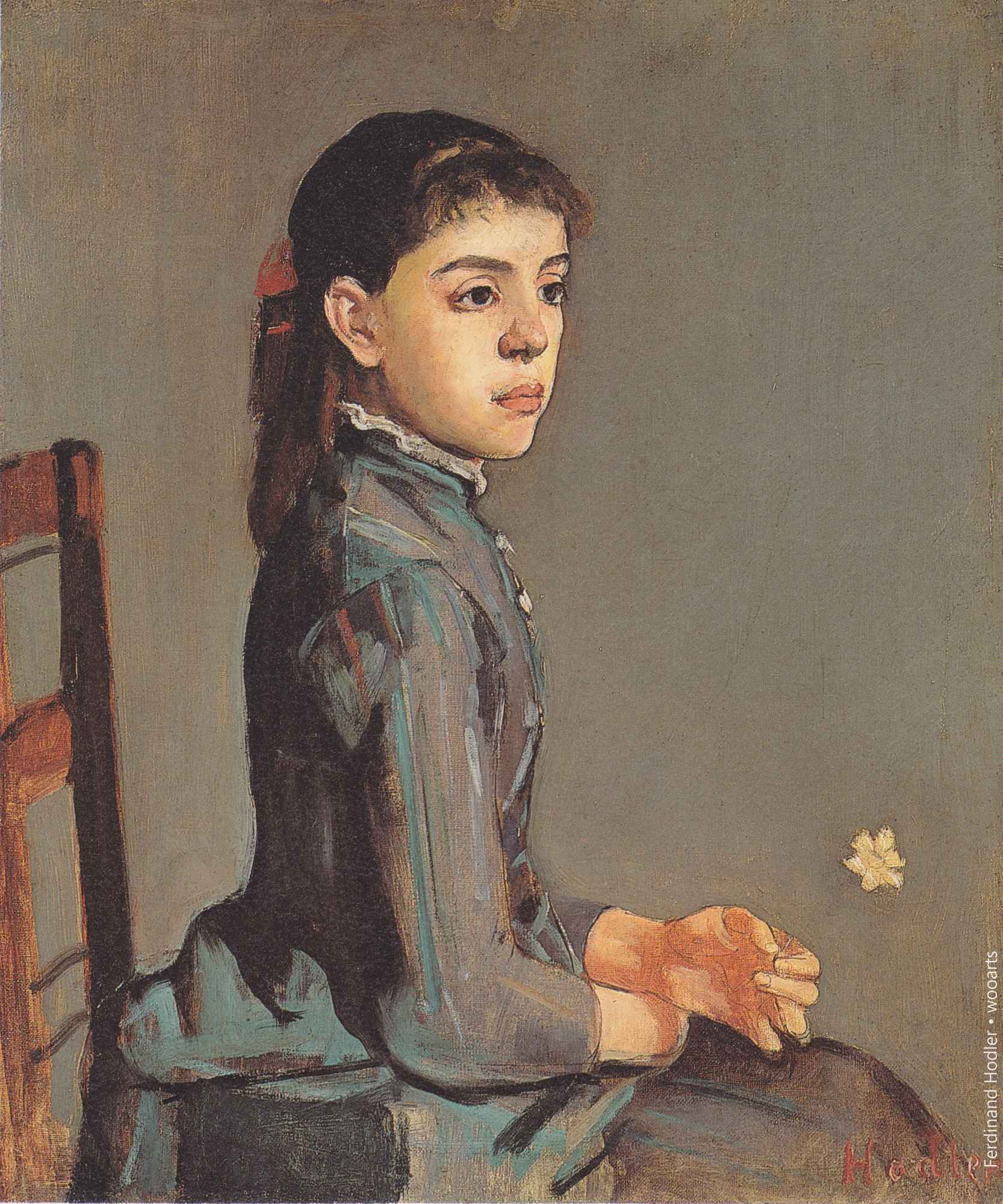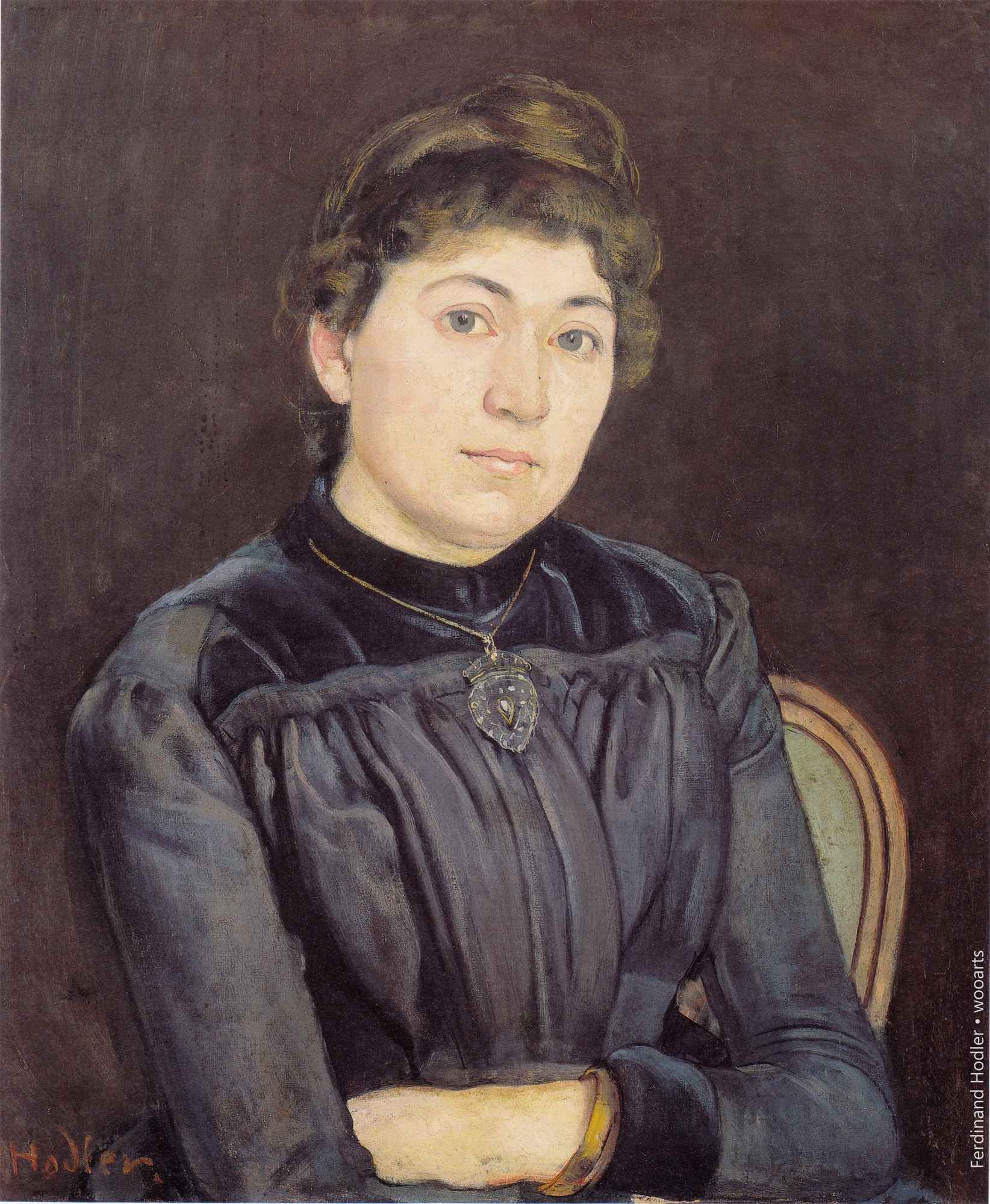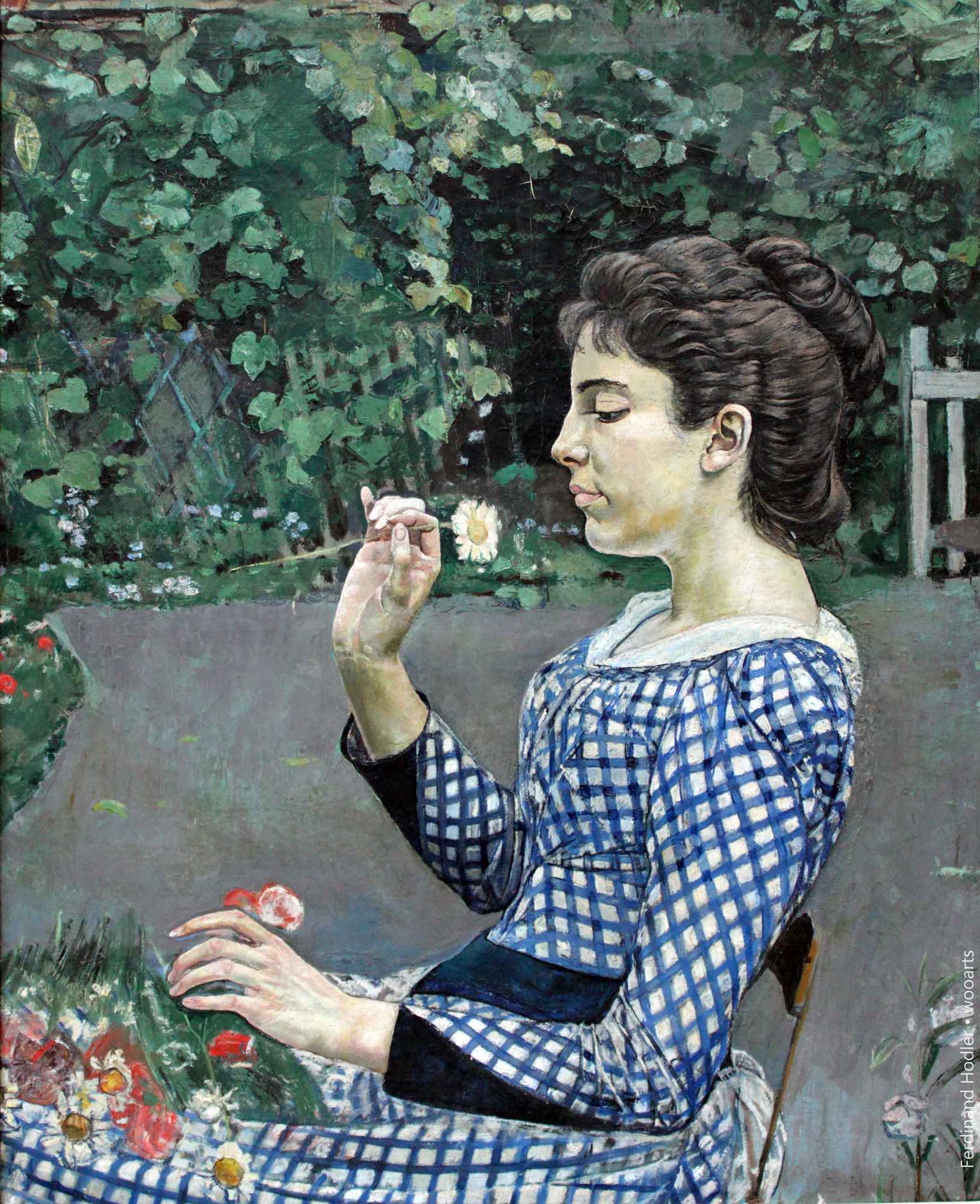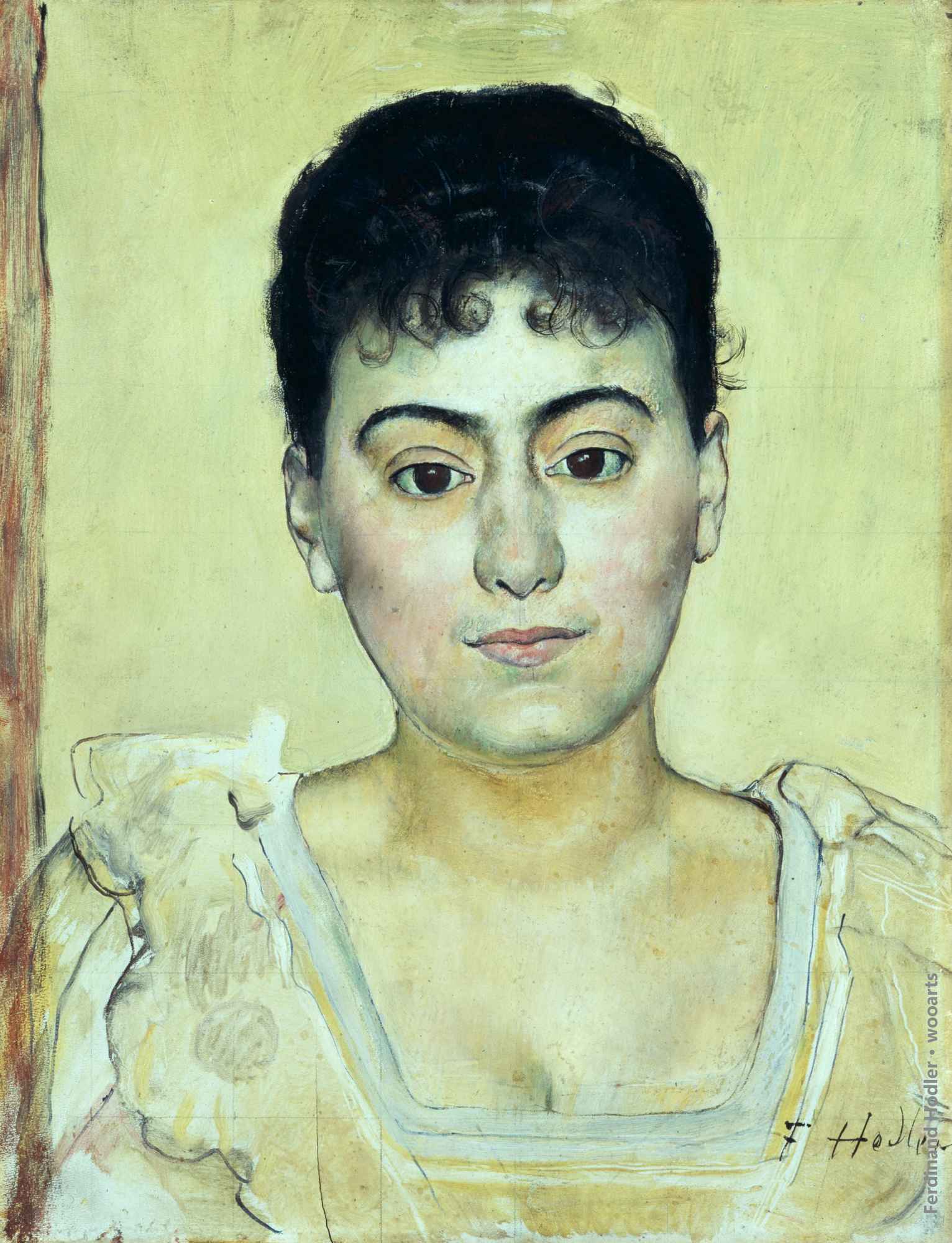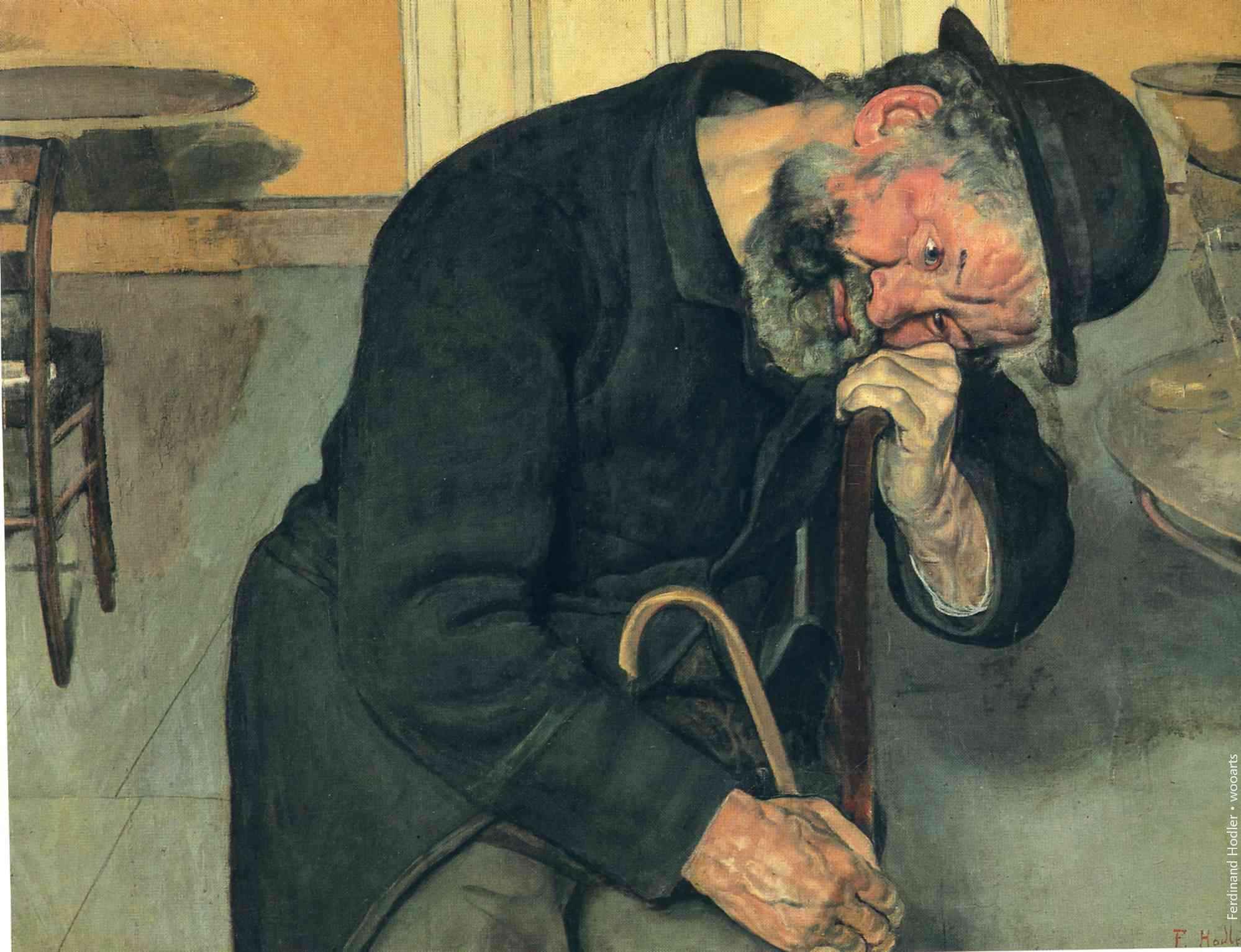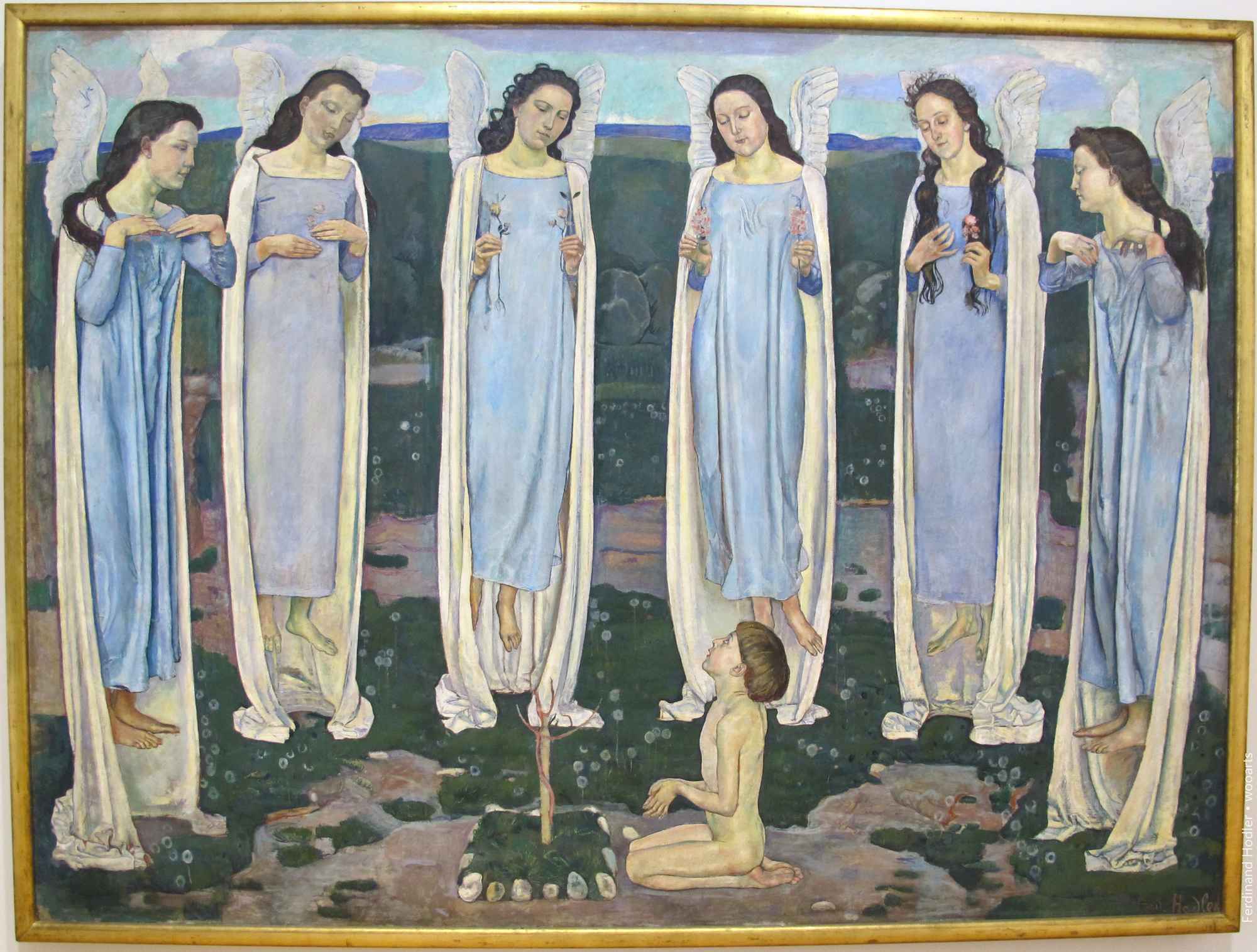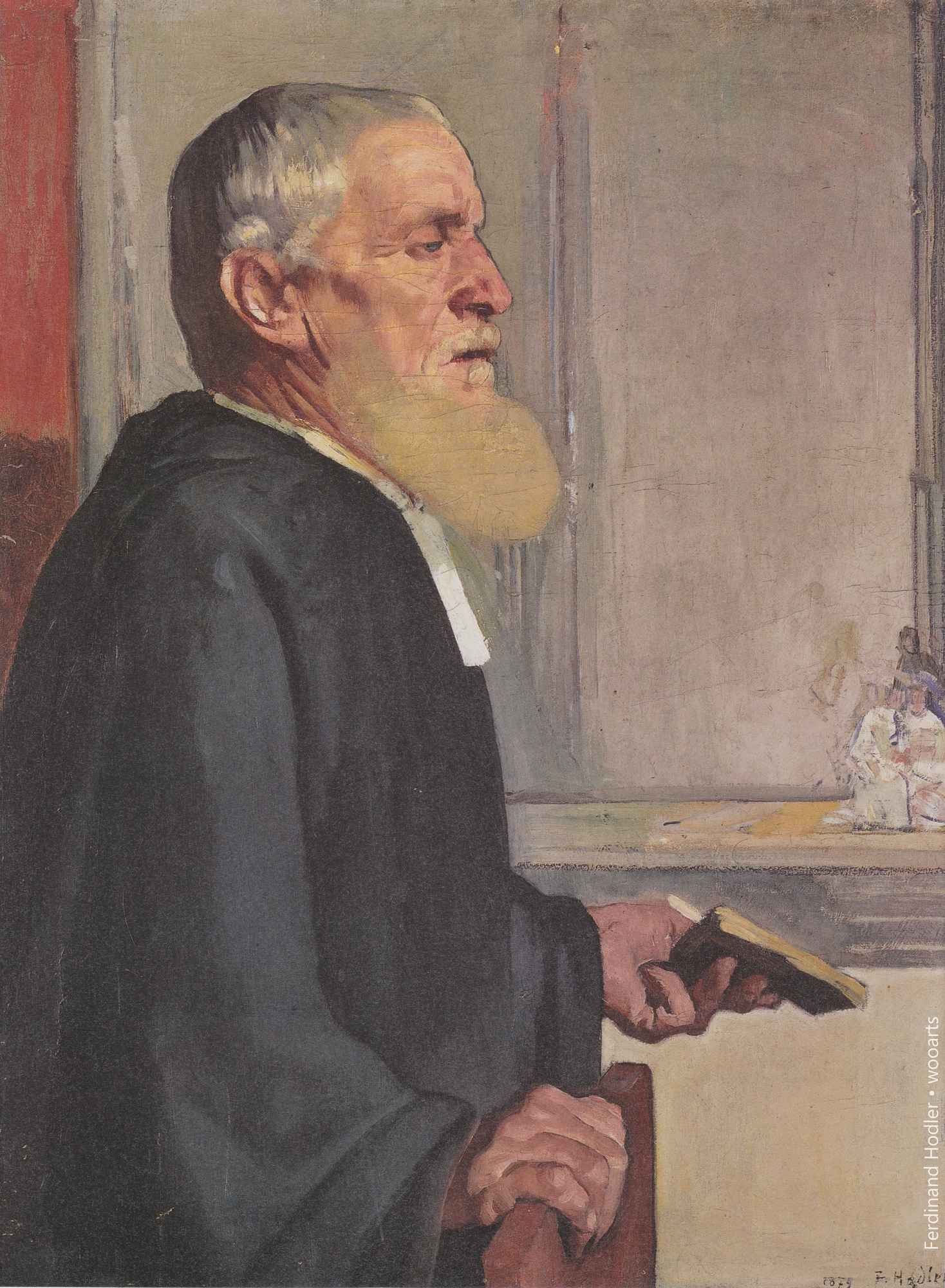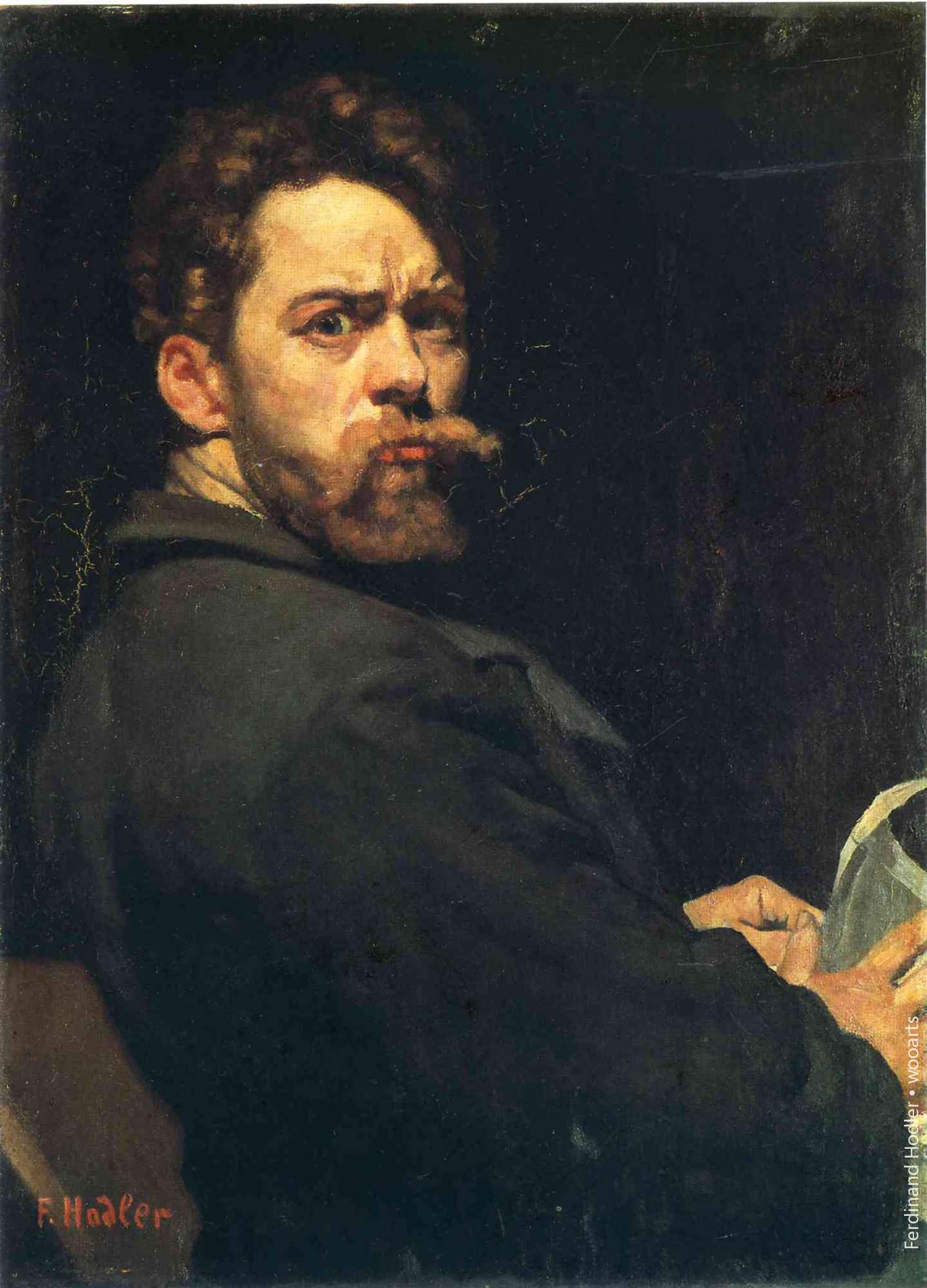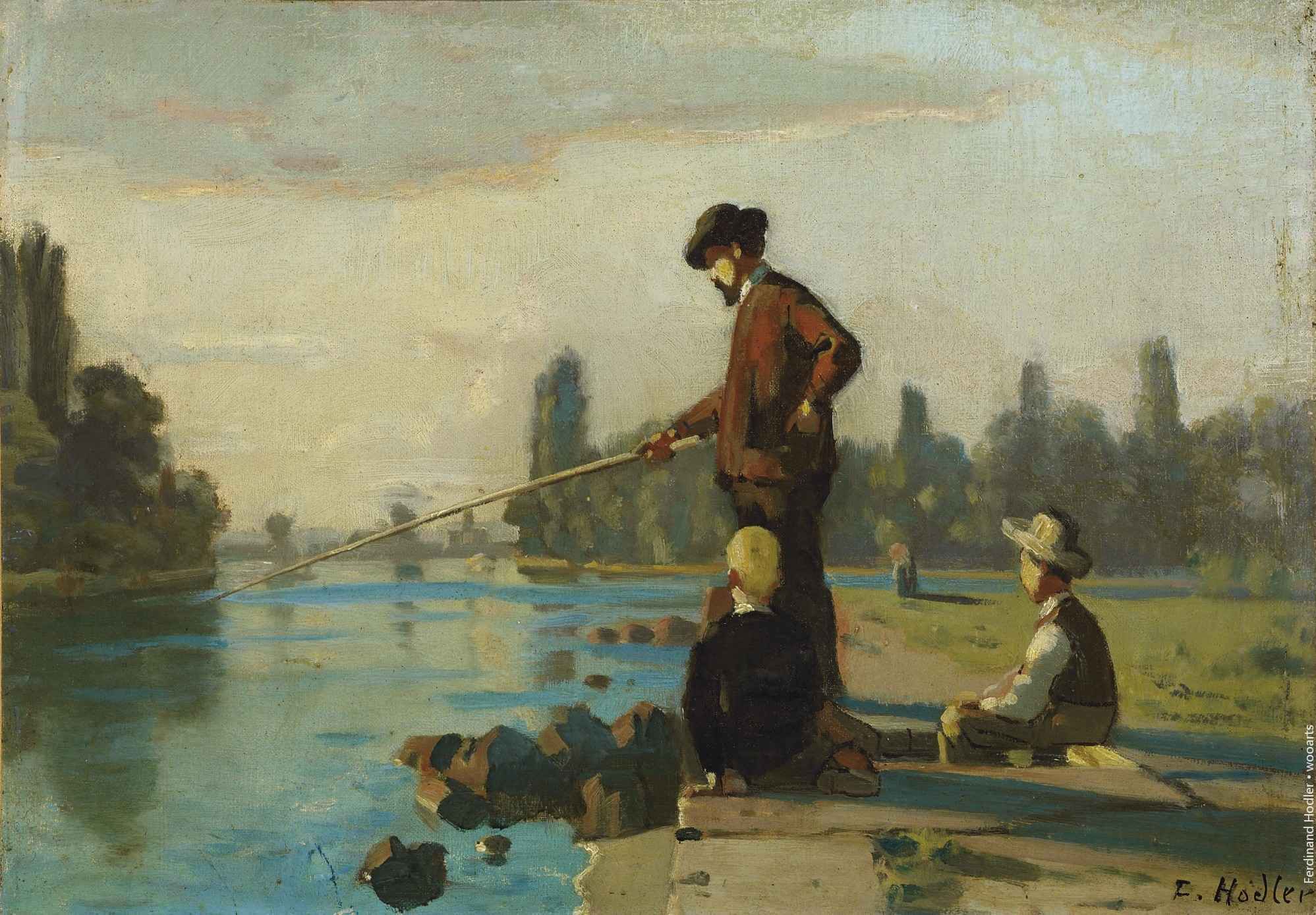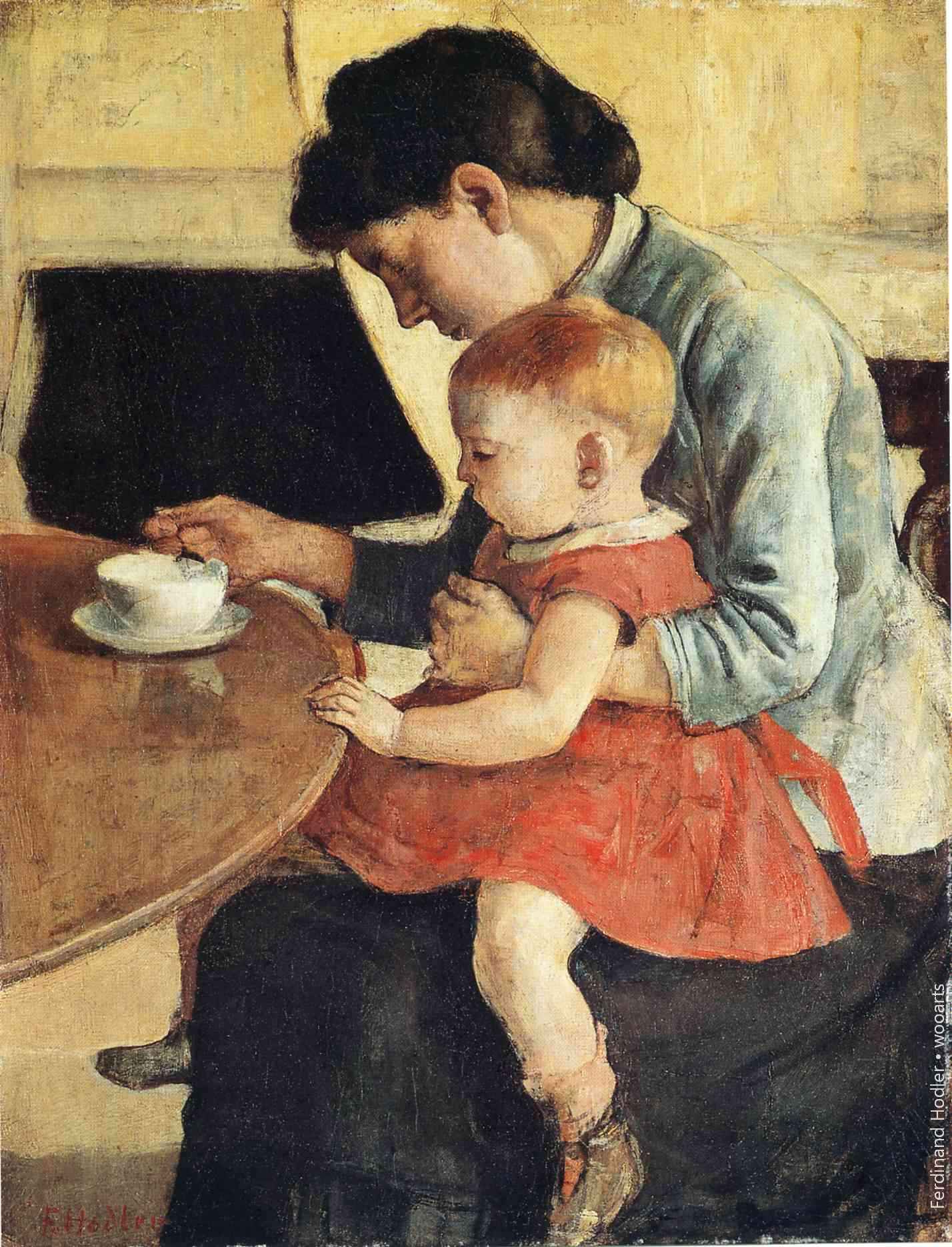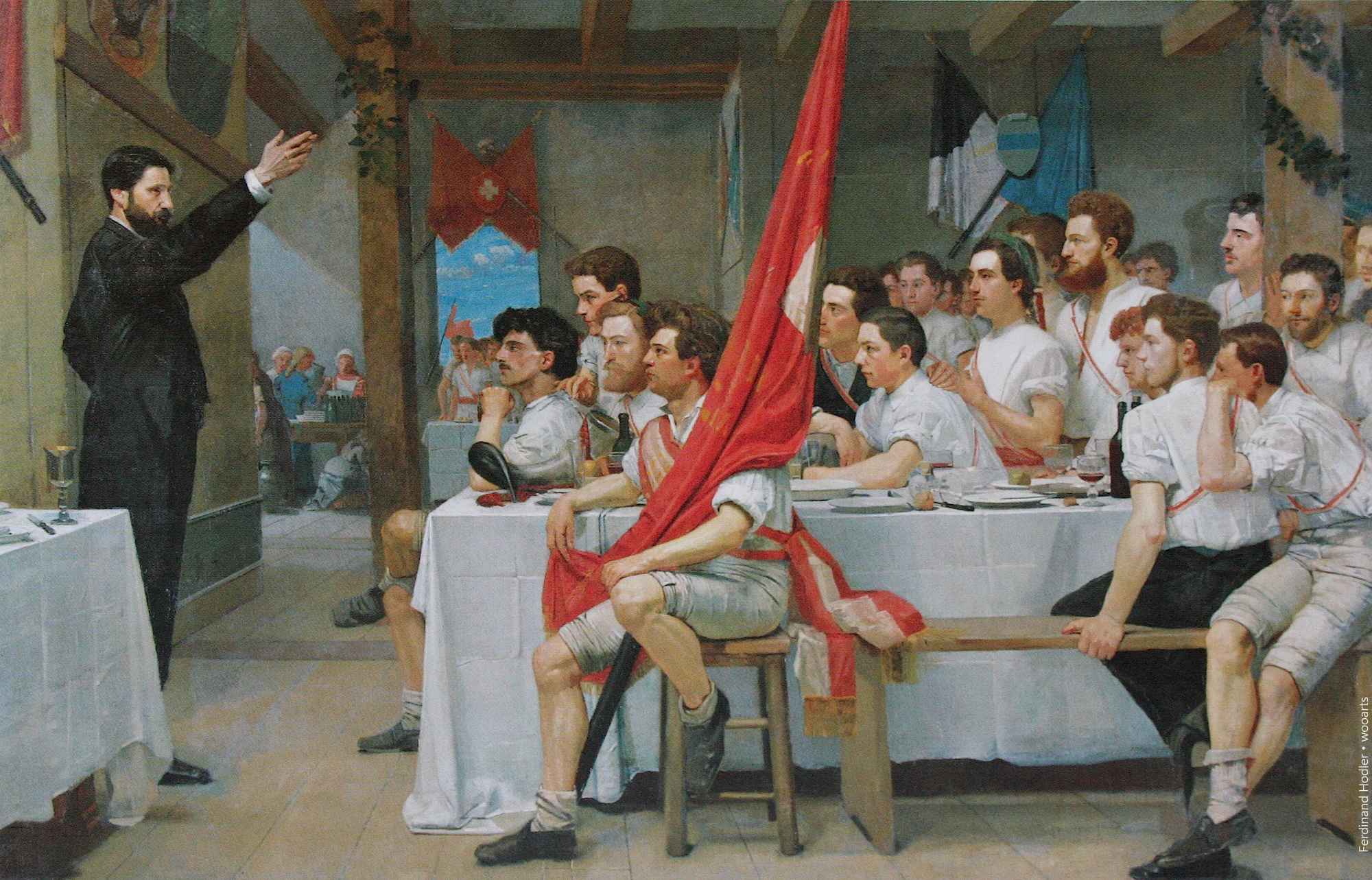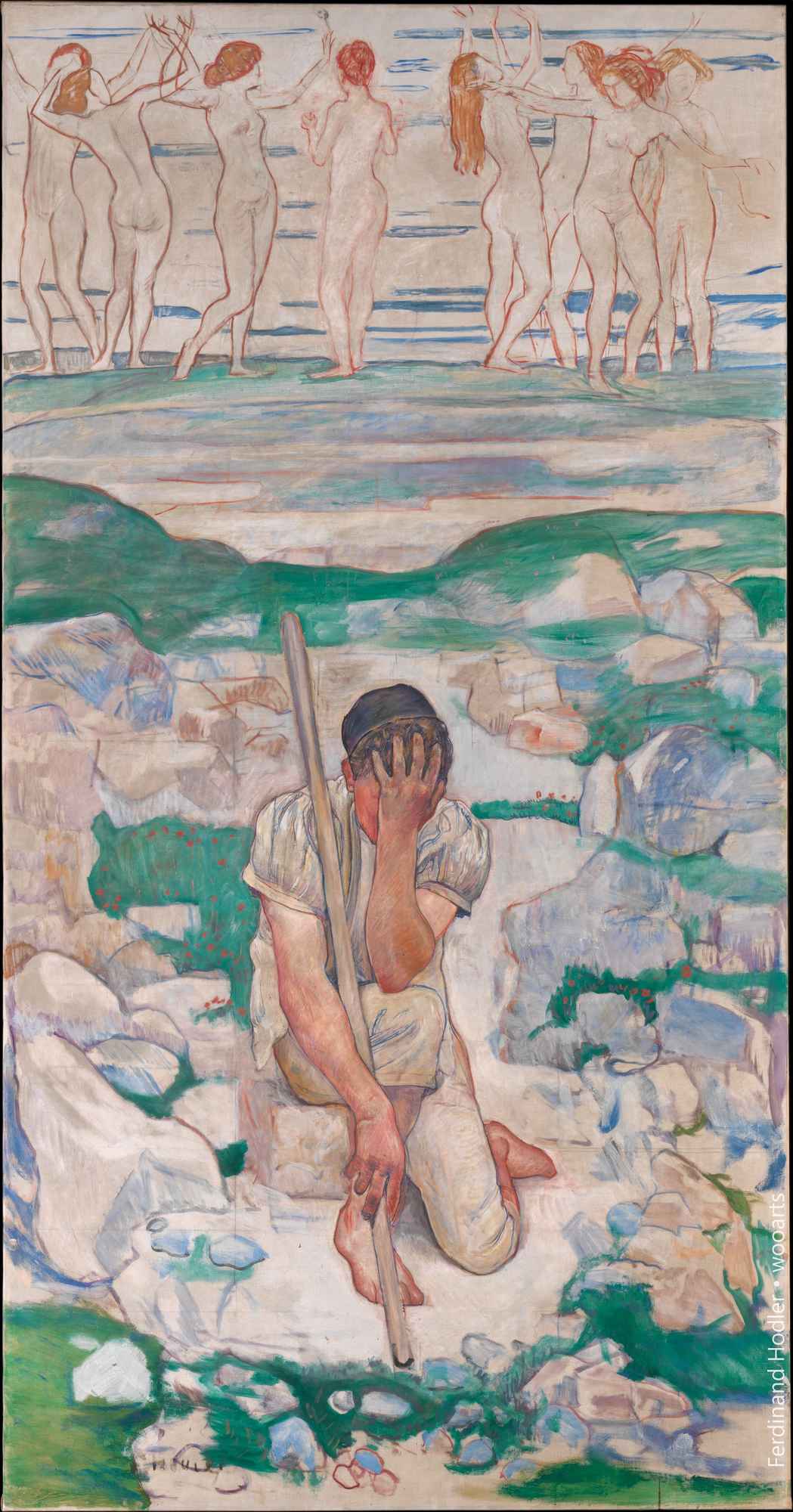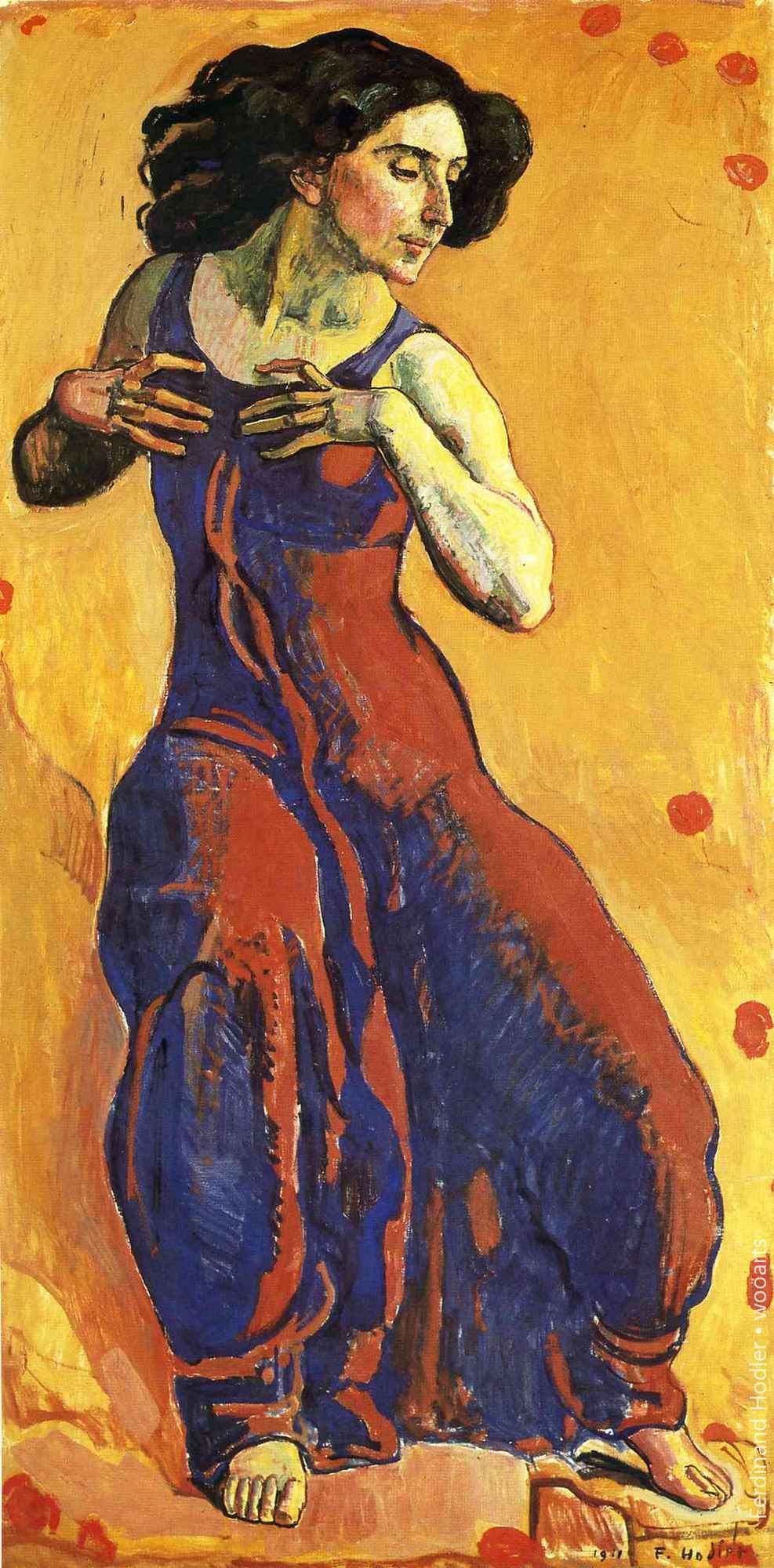Early life
Ferdinand Hodler was born in Bern, the eldest of six children. His father, Jean Hodler, made a meager living as a carpenter; his mother, Marguerite (née Neukomm), was from a peasant family. By the time Hodler was eight years old, he had lost his father and two younger brothers to tuberculosis. His mother remarried, to a decorative painter named Gottlieb Schüpach who had five children from a previous marriage. The birth of additional children brought the size of Hodler’s family to thirteen.
The family’s finances were poor, and the nine-year-old Hodler was put to work assisting his stepfather in painting signs and other commercial projects. After the death of his mother from tuberculosis in 1867, Hodler was sent to Thun to apprentice with a local painter, Ferdinand Sommer. From Sommer, Hodler learned the craft of painting conventional Alpine landscapes, typically copied from prints, which he sold in shops and to tourists.
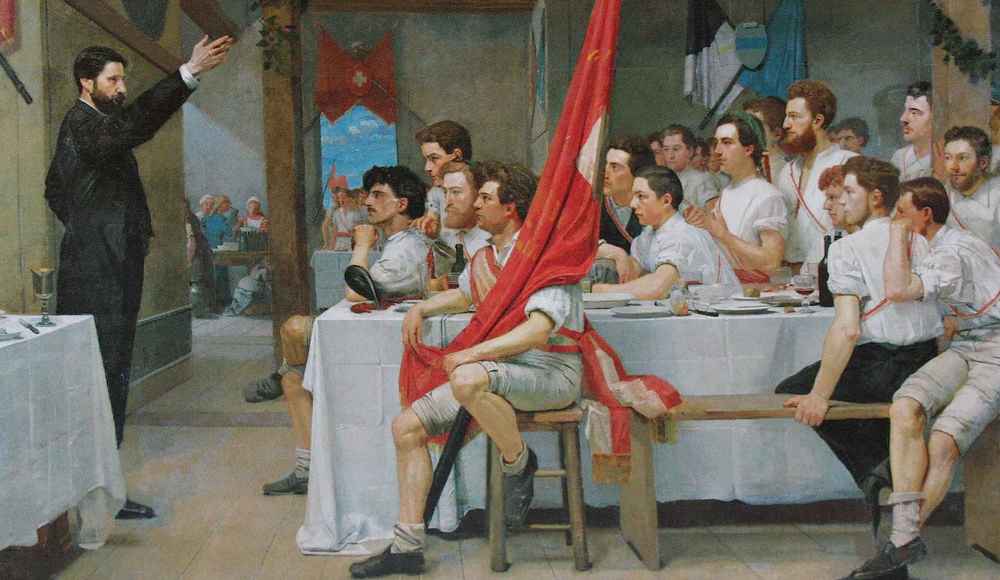
Career
In 1871, at the age of 18, Hodler travelled on foot to Geneva to start his career as a painter. He attended science lectures at the Collège de Genève, and in the museum there he copied paintings by Alexandre Calame. In 1873 he became a student of Barthélemy Menn, and investigated Dürer’s writings on proportions.
He made a trip to Basel in 1875, where he studied the paintings of Hans Holbein—especially Dead Christ in the Tomb, which influenced Hodler’s many treatments of the theme of death. He travelled to Madrid in 1878, where he stayed for several months and studied the works of masters such as Titian, Poussin, and Velázquez in the Museo del Prado.
In 1880–81, Hodler painted Self-Portrait (The Angry One), in which his expression displayed exasperation at his continued poverty and lack of recognition. It was ridiculed when displayed in Geneva, prompting Hodler’s remark to a friend that the Swiss “will not understand me until they see I have been understood elsewhere”. He submitted the painting to the Paris Salon, where it was his first work accepted, although it was ignored by the critics.
The works of Hodler’s early maturity consisted of landscapes, figure compositions, and portraits, treated with a vigorous realism. In 1884, Hodler met Augustine Dupin (1852–1909), who became his companion and model for the next several years. Their son, Hector Hodler—who would found the World Esperanto Association in 1908—was born in 1887.
Hodler was married twice. From 1889 until their divorce in 1891, Hodler was married to Bertha Stucki, who is depicted in his painting, Poetry (1897, Museum für Gestaltung, Zürich). In 1898, Hodler married Berthe Jacques (1868–1957), whom he had met in 1894.
Parallelism
In the last decade of the nineteenth century his work evolved to combine influences from several genres including symbolism and art nouveau. In 1890 he completed Night, a work that marked Hodler’s turn toward symbolist imagery. It depicts several recumbent figures, all of them relaxed in sleep except for an agitated man who is menaced by a figure shrouded in black, which Hodler intended as a symbol of death. When Hodler submitted the painting to the Beaux-Arts exhibition in Geneva in February 1891, the entwined nude figures created a scandal; the mayor deemed the work obscene, and it was withdrawn from the show. A few months later, Hodler exhibited Night in Paris at the Salon, where it attracted favorable attention and was championed by Puvis de Chavannes and Rodin.
Hodler developed a style he called “parallelism” that emphasized the symmetry and rhythm he believed formed the basis of human society. In paintings such as The Chosen One (1893), groupings of figures are symmetrically arranged in poses suggestive of ritual or dance. Hodler conceived of woman as the embodiment of the desire for harmony with nature, while a child or youth represented innocence and vitality. In Eurythmy (1895), the theme of death is represented by a row of five men in ceremonial robes walking in an ordered procession on a path strewn with fallen leaves.
Hodler painted number of large-scale historical paintings, often with patriotic themes. In 1897 he accepted a commission to paint a series of large frescoes for the Weapons Room of the Schweizerisches Landesmuseum in Zurich. The compositions he proposed, including The Battle of Marignan which depicted a battle that the Swiss lost, were controversial for their imagery and style, and Hodler was not permitted to execute the frescoes until 1900.
In 1900 Hodler exhibited three major works—Night, Eurythmy, and Day (1900)—at the Exposition Universelle in Paris, where they won awards. He was invited to join both the Berlin Secession and the Vienna Secession groups. In 1904 he showed 31 works in Vienna, which brought him enhanced recognition and a sales success that finally eased his poverty. Hodler’s work after 1900 took on an expressionist aspect with strongly coloured and geometrical figures. Landscapes were pared down to essentials, sometimes consisting of a jagged wedge of land between water and sky. The art historian Sepp Kern says that in Lake Geneva (c. 1911), “the bands formed by the shoreline, the mountains and their reflection on the surface of the water, together with the three-part rhythmic frieze of clouds, have been composed to form a cosmological whole.”
In November 1900 Federal Councilor Zemp, the president of the postal and railway department, launched a design competition for a new Swiss postage stamp. Hodler anonymously sent a design showing a Freiburg herder, which was used 35 years later in the Swiss Pro Patria-Block of 1936.
In 1908, Hodler met Valentine Godé-Darel, who became his mistress, although he continued to live with his second wife. In 1913, Godé-Darel was diagnosed with a gynecological cancer, and the many hours Hodler spent by her bedside resulted in a remarkable series of paintings documenting her decline from the disease. In January 1914, three months after the birth of their daughter, Pauline, Godé-Darel was subjected to an operation for the cancer. In June 1914, she underwent a second operation. Her death in January 1915 affected Hodler greatly. He occupied himself with work on a series of about 20 introspective self-portraits that date from 1916.
In 1914 he condemned the German atrocities conducted using artillery at Rheims. In retaliation for this, German art museums excluded Hodler’s work.
By 1917 his health was deteriorating. In November of that year he became ill with pulmonary edema, and told his son he was considering suicide. Although mostly bedridden, he painted a number of views of Geneva from his balcony in the months before his death on May 19, 1918.
Wikipedia
Ferdinand Hodler was one of the best-known Swiss painters of the nineteenth century.
His early works were portraits, landscapes, and genre paintings in a realistic style. Later, he adopted a personal form of symbolism which he called “parallelism”.
The Swiss Symbolist painter Ferdinand Hodler, a key figure as the nexus between nineteenth-century Naturalism and twentiethcentury Expressionism, is represented in the Museo Thyssen-Bornemisza by this work entitled The Reader, painted around 1885. It is a version of an oil painting dating from the same year, Old Man Reading, showing an eighty-year-old man reading a newspaper amid a room decorated with prints. Here the closer view of the figure affords it greater symbolism and monumentality.
Between 1875 and 1890 Hodler chiefly painted idealised pictures of craftsmen, such as Carpenter at his Workbench, as a means of recalling his own origins as an artisan. In all these compositions the artist attempts to concentrate on the expressive potential of the human figures. His reverential interest in elderly men, such as the one in this composition, led him to use as sitters some of the eighty-year olds who frequented the café near his Geneva home: “they confided in me and I listened to them while they posed. None of them any longer expected anything of life… They were all characterised by a desperate submission to an inevitable and inconsolable destiny… that is why I painted them.” The sitter used in The Reader is also found in The Philosophical Worker, executed in 1884, and in A Glimpse into Eternity of 1885.
Paloma Alarcó
Ferdinand Hodler: Expressionism Versus Symbolism
The University Art Museum, Berkeley, published a 140 page catalogue, contributions by Peter Selz, Eva Wyler, Phyllis Hattis, and Jura Brüschweiler, 140 pages, 118 illustrations, 18 colorplates.
THE FERDINAND HODLER RETROSPECTIVE organized by Eva Wyler and Peter Selz for The University Art Museum at Berkeley provides a unique overview of perhaps the last neglected giant figure of the turn of the century. Still, despite its many virtues, I am of two minds about the Berkeley exhibition, an affective split resulting from a tendentious presentation of the Swiss artist’s career.
In my view there are two ways of dealing with Hodler. Either he is viewed as a major Expressionist who grew out of Van Gogh’s portraiture and Cézanne’s landscapes, or he is seen as a major Symbolist figure whose contribution is informed by currents within the Symbolist movement. The former view—one held at least 50 years, since Fritz Burger brought out his two-volume Cézanne und Hodler, Einfithrung in die Probleme der Gegenwart in 1920—is the one sustained by Peter Selz, the principal essayist in the Hodler catalogue published for this occasion. (The others include Phyllis Hattis, writing on Hodler as a draftsman, and Hodler himself, his extracts having been edited by Jura Brüschweiler, a Swiss scholar and the leading Hodler authority.) Owing to Selz’s explicit Expressionist scholarly viewpoint, Hodler has been too exclusively promoted as a major Expressionist painter. Since Hodler largely remains outside general American awareness—this is his first extensive showing here although the artist died in 1918—Selz’s view will easily find popular acceptance. However, Hodler cannot satisfactorily answer such an interpretation, the importance of his later paintings notwithstanding. And without their being insignificant, it is possible that they are not as Selz would have us see them either. By contrast, Selz’s view underplays that aspect of Hodler’s oeuvre about which one can create a more intriguing modernist argument—Hodler’s Symbolist painting. For this, a few backward glances are necessary.
Ferdinand Hodler was born to the working class in Bern, Switzerland, in 1853. The class affiliation is important to note as it helps in understanding Hodler’s evolution and embitterment: large portions of his career were rendered arduous on no other basis than provincial class snobbery. Conversely, his Olympian position during his later successful years was enlarged by this selfsame proletarian undertone. Despite a once major prestige, he is now only beginning to break with a primarily local esteem. In the period preceding the First World War, Hodler was—with few peers save Rodin and Monet—viewed as a force of nature, the way Victor Hugo had been regarded in the 19th century.
The central theme of Hodler’s work is death—as it was for so many others, Symbolist and/or Expressionist, the union as well not being uncommon, e.g., Edvard Munch. Hodler underwent driving deprivation at first hand and the experience as well of a family deathwatch as he observed brothers and sisters die one after another in metered sequence. The death of Hodler’s father occasioned his mother’s remarriage, and of the 12 children that made up the combined families, only six survived into maturity, the others having died of tuberculosis. The deaths, too, of the major female figures who shared Hodler’s life were closely observed and resulted in the series of his finest late Expressionist portraits, those of Augustine Dupin on Her Deathbed, 1909 (Fig. 1). Unlike many other explorations of the theme of death in the 19th century, Hodler’s was based on his own intimately and agonizingly lived and relived experience. The first programmatic Symbolist canvas, The Night, 1890 (Fig. 2) attempts to come to grips with a theoretical consciousness in conflict with larger Realist precepts discernible in the painting of The Night’s individual figures. This Realist approach particularly distinguishes Hodler’s early works from the pious Swiss academism and the local landscape tradition in which he was first trained. Throughout his life Hodler venerated his teacher, the Swiss landscapist Barthelemy Menn, a student of Ingres, who intensified Hodler’s attachment to drawing and exacting contour as an end in itself, even above such alternative Helvetian models as Hans Holbein, whom Hodler, being Swiss himself, must have studied,especially for his early patriotically themed, public decorations.
The Night, composed of sleeping male and female figures in amorous positions, is dominated by the central terrified awakened figure—a self-portrait upon whose body a succubus has been perched. The connection between this work and the several versions of The Nightmare by the 18-century Swiss artist, Henry Fuseli, has often been drawn; and Selz’s recognition that the figure “deals with the nightmare of sex and death” continues to correctly interpret the figure in this tradition. Hodler had inscribed on the frame of the work the following admonition: “more than one who tranquilly retired at night did not awaken the following morning.” The erotic aspects of the work are self-evident, and further supported by the identification of the female figures as, among others, Augustine Dupin. The diagonally placed sleeping couples investigate figure compositions of lovers more fully realized in many paintings on the theme of procreative love, which, like the figures of Rodin, are endowed with Michelangelesque musculatures. In many respects, the analogous artists to Hodler are not Cézanne or Van Gogh, as Selz’s argument (and installation) suggests. Rather they are Puvis de Chavannes and Rodin if we examine the themes and figure types of the Symbolist can, vases.
The parochial indignation of the mayor of Geneva on viewing The Night in the 1891 municipal exhibition led to its expulsion and obliged Hodler to exhibit the work in the Salon du Champ-de-Mars, the official salon of the most conservative art society in France where, ironically, it was received enthusiastically, particularly by the critic Arsene Alexandre. The success of this work in the capital of art led to the burgeoning of Hodler’s international fame. His Parisian reputation was assured when, in the following year, he sent Tired of Living, 1892 (Fig. 3) to the official salon and The Disillusioned, 1892 (Fig. 4) to the first Salon de la RosetCroix installed in Durand-Ruel’s gallery. The symbolic content and focus on Italianate drawing typical of Hodler’s work in the 1890s would make the artist an obvious candidate for inclusion in the Rosicrucian exhibition, although there is, as yet, no proof of Hodler’s solidarity with the Rosicrucian movement despite such inferences by Hodler’s early major biographer and documentor, Carl Albert Loosli.Jura Brüschweiler agrees with me that Hodler’s association with the then newly revived mystical confraternity signified only that the artist was seizing an opportunity to confirm his toehold in Paris.
The two works shown in Paris in 1892 more clearly convey the dualistic structure of Hodler’s Symbolist imagery, The Disillusioned being the black versionand Tired of Living the white of the friezelike “parallel” ordonnances of Hodler’s public style. (The smaller Expressionist portraits and landscapes more convincingly fall within the purlieu of a private style.)
Polarized coordinates are typical of Hodler. The Night, which opens the symbolic phase so brilliantly, cannot really be said to be completed until the painting of the final version of The Day, 1905 (Fig. 5), a work coincidental with Fauvism (and in which certain Divisionist passages of color are perhaps Fauve-like). The Night, with its many homo-erotic clues (an important, neglected aspect of Hodler’s entire Symbolic phase, although there is no question concerning the artist’s personal heterosexual orientation), is balanced by the focus on female sexuality implicit in The Day. The Night’s concern with death is countered by The Day’s focus on life. The symmetry of The Day, balanced parenthetical curves surrounding a central vertical figure, is vaginally implicit. The center of the composition is marked by drapery covered female genitalia. Similarly, the figure of death slouches upon the male genitalia in the center of The Night. The Day can be understood to concern birth as The Night symbolized death. These theatricalized compositions illustrate the duality of birth and death—in short the unity of existence.
Numerous canvases deal with, if not the clinical details of birth, related subjects—The Chosen, 1893 (Fig. 6) being among the more esoteric of them. In this composition six angels hover about a child kneeling before a sapling rendered in a revivalizing taste for pre-Raphaelite and northern Renaissance art—equally noticeable in the work of Hodler’s Swiss colleague, Carlos Schwabe, the designer of the poster of the first Salon de la Rose+Croix (Fig. 7).
In the exhibition and the catalogue Selz’s view is delineated through a thematic isolation of three distinct areas, portraits, landscapes, and Symbolist compositions, the latter underplayed in favor of the former.’ Evidently, while the landscape and portraits become predominant after the opening of the 20th century, they are certainly not rare in the earlier Symbolic phase of Hodler’s painting: Selz himself observes that it is in an early quasi-I mpressionist landscape, the 1885 Beach Forest, that the artist’s celebrated theory of parallelism is first enunciated. Parallelism is a simple principle of abstraction through which Hodler hoped to introduce “a feeling of unity . . . an element of order.” The tendency toward theoretical thinking reflected in Hodler’s extensive notes on art reveals an immense appreciation for the theoretical or abstract position similar to the views of the Nabis. Perhaps the most startling note of all comes from the Painter’s Decalogue (c. 1874), a ten-point set of rules that reminds one of Maurice Denis’ famous dictum of 1890: “A painting is above all else a flat surface covered in colors arranged in a certain order.” Almost 15 years earlier Hodler had written in the Decalogue that “the painter must practice seeing nature as a flat surface.”
The desire to infuse parallel rhythms into natural movement led Hodler to compose large friezelike compositions. These are based on polarized philosophical themes, ambiguous personnages who in slight variation echo and respond to one another’s attitudes. The relationship of such postures to the history of dance seems inevitable. Recent research now postulates Hodler’s connection to the dance movements of his friend, Emile Jacques Dalcroze, the founder of Eurhythmics, a system of choreography allied to the mystical thinking of the Anthroposophists, Rudolph Steiner particularly. Among Hodler’s major Symbolist canvases is the work called Eurythmy, 1895 (Fig. 8), a parallel figure composition of five old men garbed in white robes, an image of “five men representing humanity, marching toward death,” as Hodler described it, a work that reflects Rodin’s group, Les Bourgeois de Calais. Considering the present state of research on Hodler, one may still assume that the influence runs Hodler-Dalcroze as much as Dalcroze-Hodler. (By way of indicating the pivotal nature of Hodler’s work, one is tempted to point out the symbolic figure compositions of Hodler as models for the Matisse versions of The Dance.)
A personal interest in the Symbolist movement may have made me less responsive to the implications of Hodler’s later, more intimate work. However, it is not for arcane or esoteric value that I am intrigued by the earlier Symbolist painting, but because the problems inherent in this work led to major European art in a way that the purportedly “great painting” of Hodler’s Expressionist portraits and landscapes did not. In examining the archaizing postures of Hodler’s figures, e.g., The Day, one finds the models for the work of several Swiss artists whose early efforts were deeply influenced by Hodler, most particularly Louis Moilliet and his more famous comrade, Paul Klee. In their work we discover the Hodler manner transposed into miniature graphics. It was Moilliet (along with Auguste Macke) who was Klee’s travelling companion on the trip to Tunis in 1913, the journey that opened Klee to the possibilities of color. When one compares Moilliet’s Virgin in a Tree, 1903 (Fig. 9) and Paul Klee’s version of the subject of 1903 (Fig. 10), they reveal the obvious and most profound imprint of Hodler’s Symbolist style. The greatness of Hodler in the modern period is, I believe, not so much what he achieved in the 20th century—despite its self-evident virtues—but more in terms of what his Swiss successors were obliged to overcome of Hodler in their own evolution. In this sense, that is, as something once part of an evolution and at length rejected, we see the vitality and importance of Hodler’s achievement for modern art. Thus Hodler’s importance is not a function in conventionalized notions of Expressionist painterly values, however remarkable these paintings may be in themselves. To be sure, Hodler was a regional artist. However, his enrichment of a local tradition became the means whereby that tradition was able to internationalize itself in a way potentially significant to the larger history of modern art.
The exhibition will travel to the Guggenheim Museum, February 2–April 8, and to the Busch-Reisinger Museum, Harvard University, May 1–June 22.
—————————
NOTES
1. The Berkeley installation at least stressed thematic isolation—a production lucidly divided into three parts. By contrast, the New York installation about which one anticipated a chronological hanging that corresponded to the Guggenheim spiral ramp was disappointing. Instead of chronology, this installation combined options, freely intermingling theme and chronology on the basis of an interesting, but private taste. Hodler’s oeuvre—in spite of the fresh light which revealed an occasional unsuspected coloristic range—was reduced thereby to a directionlessness which rendered arbitrary the already difficult contradictory nature of his accomplishment.
Source: artforum.com
Ferdinand Hodler and Berlin Modernism
Ferdinand Hodler’s (1853-1918) expressive figure paintings, mountain landscapes and portraits are icons of modernism. Even during his lifetime, the work of the Swiss painter, who helped shape Symbolism, received great international attention. What is hardly known today: Hodler’s path to fame led via Berlin. From 1898 until the beginning of the First World War, the artist exhibited here almost every year. The exhibition “Ferdinand Hodler and Berlin Modernism” shows around 50 paintings by the artist, including 30 from the Kunstmuseum Bern, which is a cooperation partner of the show. In addition, there are further works by artists from the Berlin Secession who exhibited with Hodler in Berlin, such as Lovis Corinth, Walter Leistikow, Hans Thoma and Julie Wolfthorn.
Contemporaries saw in Hodler above all the “human actor who knows how to shape the soul through the body”, according to the artist Paul Klee in 1911. Hodler’s art focused on simplification and grandeur. The timelessly elegant postures and delicate faces of his dancers and young men are still captivating today. They appear archaic, often serious and yet also soulful, full of lightness and life. Hodler drew for his art from nature, of which he understood man to be a part. The air that his figures breathe and his mountains waft is cold and clear. The artist, Hodler himself wrote in one of his programmatic texts, “shows us a magnified, a simplified nature, freed from all details”.
Today, Ferdinand Hodler is undisputedly Switzerland’s most popular painter and, alongside Paul Cézanne, Vincent van Gogh and Edvard Munch, is regarded as a key figure in modern art. His work was last shown on a large scale in Berlin in 1983. The exhibition at the Berlinische Galerie presents the artist for the first time as a major figure in Berlin’s modern art. A selection of his most important Symbolist figure paintings, which established Hodler’s success in the German capital, his unmistakable mountain landscapes and outstanding portraits, which already inspired the contemporary Berlin public, can be discovered: “In the Künstlerbund exhibition. The strongest impression Hodler,” noted the influential collector and patron Harry Graf Kessler in his diary in 1905, for example.
The exhibition “Ferdinand Hodler and Berlin Modernism” traces the Swiss artist’s success story on the Spree. Here, his works were first shown at the Great Berlin Art Exhibition, then at the Berlin Secession and in renowned galleries in the city such as the Fritz Gurlitt and Paul Cassirer art salons. Already in his own time Hodler was perceived as a typical exhibition artist, who made a career across Europe beyond the Swiss borders. After initial successes in his native country, where Hodler’s work was the subject of controversy, he established relationships in Paris, Munich, Vienna and Berlin, where he showed his works in the context of leading avant-garde associations.
The rather Prussian-sober mentality in Berlin initially made it difficult for Hodler to assert himself with his Symbolist figure paintings. The Swiss artist polarized. He inspired artists and critics who were open to modernism. He was only gradually able to win over the wider public, who were still familiar with Naturalism and Impressionism in Berlin. When the gallery owner Paul Cassirer included Hodler’s early Naturalist work as well as portraits and landscapes in a group exhibition in 1907, the artist gained wider acceptance in the city. It was also Cassirer who mounted an extensive monographic show for Hodler in 1911. Part of a larger exhibition tour that included Cologne, Frankfurt am Main, Berlin, and Munich, it considered all facets of Hodler’s work. Particular emphasis was placed on the landscapes, which enjoyed great popularity among collectors.
In the second half of the 1900s, Expressionism announced itself in Berlin. For the art scene of the metropolis, this led to a paradigm and generation shift around 1910/11. Hodler was already regarded at that time as a pioneer of Expressionism and Abstraction because of his tense outlines, which today seem almost comic-like, and his free language of color and form. When the Swiss artist, together with other artists and intellectuals, signed a protest in Geneva against the shelling of Reims Cathedral by German troops immediately after the beginning of the First World War, this triggered a wave of indignation in Germany. The press turned it into the “Hodler case”, which led, among other things, to the painter being expelled from German artists’ associations. By the end of the war, however, the artist, who died in May 1918, had been largely rehabilitated in Germany.
via: berlin.de
